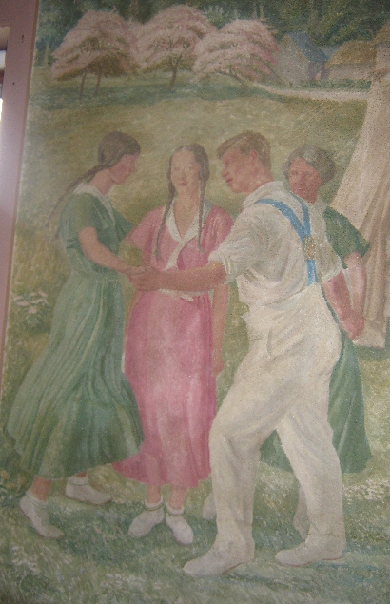
I spent the weekend following my attendance at the ICS Chaplains and Families Conference, visiting my two adult children. Then, having met up with my nephew Tim in Leamington, I spent a couple of nights in South Wales, reconnecting with two friends from my time at University in Lampeter during the mid 1970s. I then drove from South Wales to the south coast of England, to spend my last two nights on British soil, staying with my sister June and brother-in-law Garry, at their home in Bournemouth.
On the last stage of my journey, I decided to make a short detour from the the A338 between Salisbury and Bournemouth, to visit the small village of Woodgreen on the edge of the New Forest. I wanted to once more see the unique murals painted on the walls of the village hall, in which my mother, aunt and uncle all appear.
Woodgreen Village Hall was built between 1930-31. Over a period of eighteen months in 1932-33, two students from the Royal College of Art in London, Robert Baker and Edward Payne, created a series of murals covering the interior walls of the hall, depicting village life at the time. One of the scenes depicts a group of country dancers and it is in this mural that my mother and her sister and brother are all depicted.
This photograph shows the left half of the country dancing mural. The young lady in the pink dress standing in the centre of the circle created by the other three dancers, is my mother Elsie Cutler. At the time this was painted she was either sixteen or seventeen years old. The young lady in the green dress on the left of the photograph, (on my mother’s right), is her older sister Edith Cutler, always known to me as my Auntie Edie.
Below is a photograph of the complete mural. The young man on the left of the dancing circle on the right side of the mural, is my Uncle Cecil John Cutler.
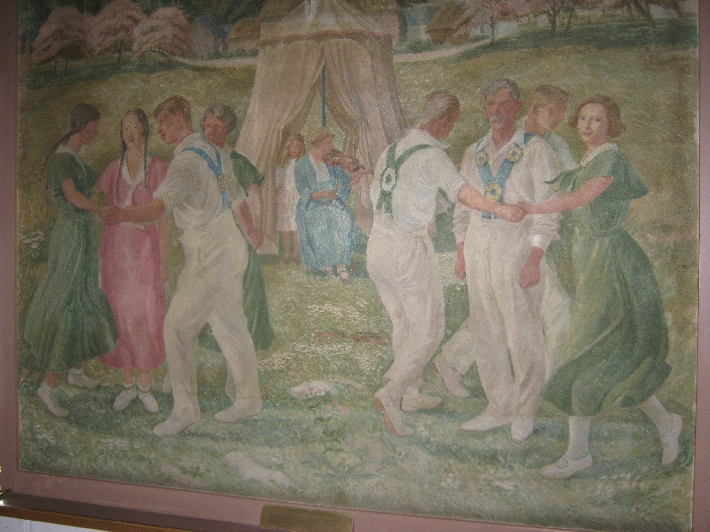
Strictly speaking, my mother and her sister and brother, did not live in Woodgreen. They lived at Godshill Wood Farm, located halfway between Woodgreen and the neighbouring village of Godshill to the south. However, as the country dancing team was based in the village of Woodgreen, they were included in the mural painting.
Last year, the Woodgreen Village Hall Management Committee organised a party to celebrate the eightieth anniversary of the murals to which those who are featured in them who are still alive, were invited, along with the descendants of those now deceased. There is a report here, which includes a link to photographs of the event.
Unfortunately, neither my sisters and I, nor my cousin David, son of my Auntie Edie, were invited to attend. My Uncle Cecil John never married and had no offspring. The reason we were not invited was due to none of us having the surname ‘Cutler’, because of our respective mothers marrying and taking the surname of their husbands. Another cousin who does have the surname ‘Cutler’, was asked if he was a direct descendant. He rightly said that he wasn’t but didn’t have the common sense to give the organisers our details, even though he knew them 🙁
However, when I called at the home of the village hall caretaker, to ask if I could see the murals as my mother appeared in them, she freely let me have the key to gain access, hence I was able to take these photographs. My sister June has since told me that they now do have our contact details. Therefore, if there is to be a ninetieth birthday party, hopefully we may be invited.
On Thursday 22nd May, my sister June and I travelled as foot passengers on the ferry from Lymington, to Yarmouth on the Isle of Wight, where we were met by our sister Jenny who lives on the island. We had a most enjoyable day together, during which I took this photograph of the two of them.
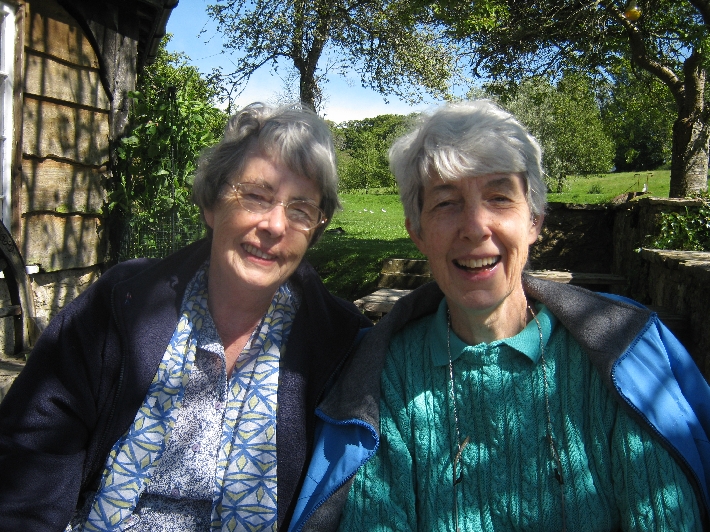

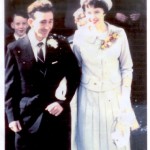
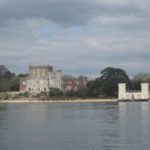
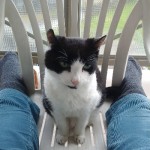
Hi Ricky,
That mural is a wonderful piece of social history and family history for all those represented, thank God it has survived the intervening years and our mad dash to ‘modernise’ and ‘renovate’ such treasures out of existence. When I was a boy, my paternal grandfather lived with us, (a common thing in the Ireland of the time), and like many elderly people he was full of stories of his youth in the late 1890’s and early 1900’s. He also tried to impart to me the family history and where all his brothers and sisters had emigrated from Ireland. I was a foolish youngster and had no interest in ‘silly old tales’, oh how I regret that today! Thank you for sharing this piece of your own history with us.
Hi Sean,
That mural, together with the other five, are a wonderful piece of social history. Fortunately now, the value of them is fully recognised with the village hall being declared a Grade 2 listed building in order to protect them. There has also been recent restoration work carried out to preserve them for future generations.
Surprisingly, I never saw the murals as a child. The first time I remember seeing them was with my mother in 1975 when I drove her from our home in Coventry, where she had lived since the early 1940s, down to nearby Fordingbridge, so she could attend the funeral of her eldest brother, (who doesn’t appear in the murals), my Uncle Ern. I was glad I did learn more from my mother about her side of the family during the last years of her life, before she herself died less than five years later in 1980.
Hi Ricky
I’m so pleased that you posted this. I’ve been taking many friends to these murals over the years – including your great-niece Lilith and great-nephew Silas’s maternal grand mother Avril.
I visited them about ten years ago with June and Lilith, who I think has a definite resemblance to Elsie. The hall was hosting a Women’s Institute tea party. The tea drinkers were delighted to see four generations together. And apart from me they could see the likeness.
Many thanks
Tim
Hi Tim,
I’m glad you enjoyed this post. I think my recent visit was the fourth time that I’ve seen the murals. As I remarked in reply to an earlier comment here, I didn’t see them myself for the first time until 1975 when I was twenty-three. I agree with you – there is a greater resemblance to my mother/your grandmother in the female descendants rather than in us males 🙂
What a wonderful thing to see your mother, aunt and uncle immortalised in these murals, Ricky. It was very imaginative of the those responsible for the building of the hall to have it decorated in such an original fashion and it’s great that the murals have not only survived but but been professionally conserved.
It was a wonderful & imaginative idea to have the interior walls of the village hall decorated in this way. The murals are a unique record of village life at the time they were created. Fortunately their value is now recognised with the hall being made a Grade 2 listed building and with professional advice being given and followed to ensure their preservation. I did enjoy taking Sybille to see them about eight years ago (the last time I saw them), and being able to say, ‘That’s my mother, my aunt and my uncle’, even though she never met any of them because they were all long deceased.
I used to know some Cutlers that lived at Marazion Cornwall. Right opposite St Michael Mount.
In fact they were neighbours. His ancestors owned Cutler’s wharf on the River Thames.
Maybe you are connected in some way.
I doubt it Arthur as my mother’s family were farmers in Dorset & Hampshire. But many thanks for both the comment & the thought.
Hi Ricky, I’m a Woodgreen resident and stumbled across your blog looking for information about the ‘country dancers’ mural. It’s reputed that the dancers competed in a national competition and appeared at the Royal Albert Hall. Do you know anything about this?
Hi Steve – Thank you for your comment. I know the country dancers did enter competitions but my mother certainly never mentioned appearing at the Royal Albert Hall. My eldest sister June, who is our family historian, might know more.